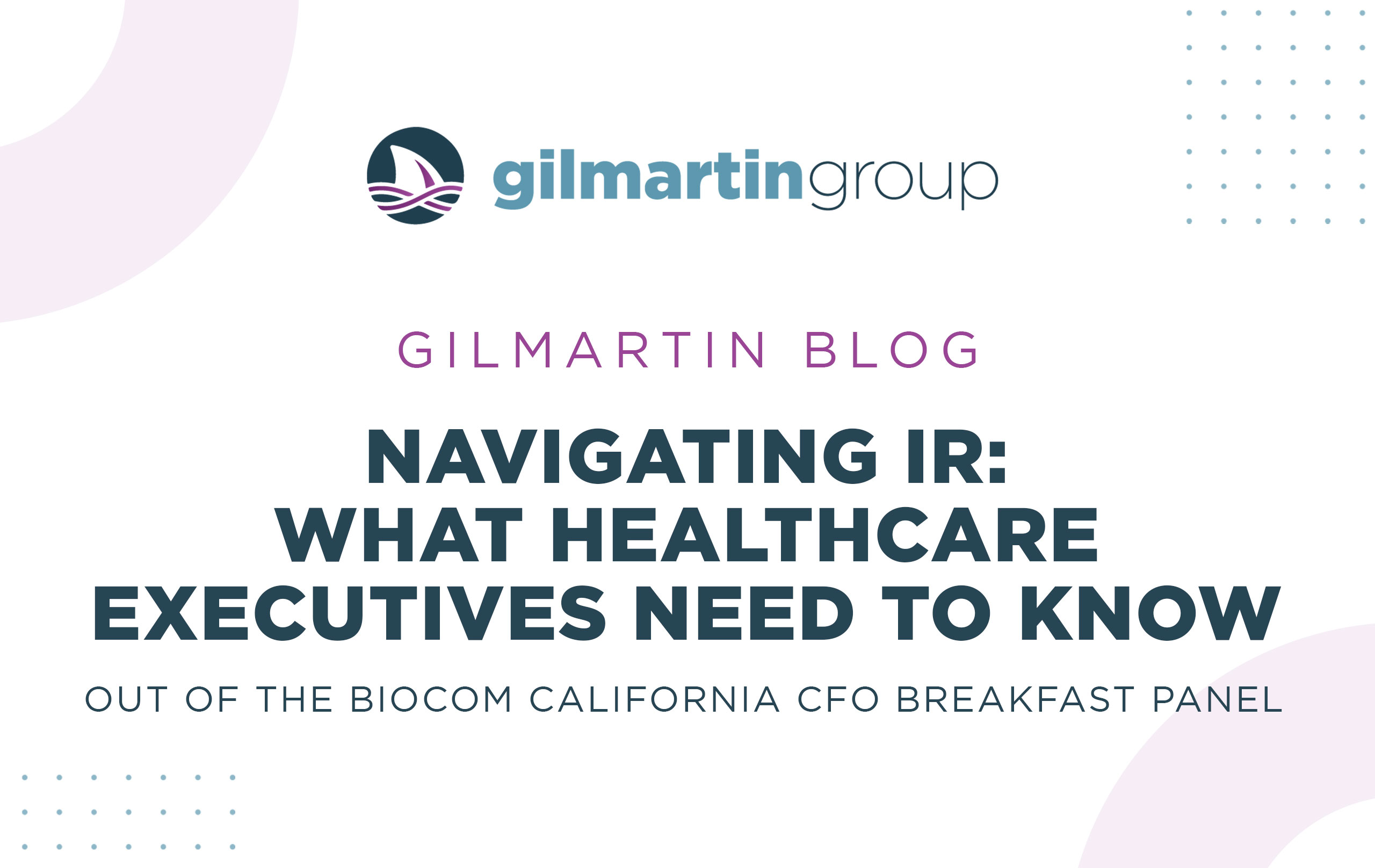Last Wednesday, April 5th, Gilmartin Founder & CEO, Lynn Lewis, moderated a panel at Biocom California’s CFO Breakfast & Networking Event in San Francisco. Joining for the discussion were John Craighead, PhD, CFO & Head of Corporate Development for Elpiscience, Celia Economides, CFO of Gritstone Bio and Jason Mills, Executive Vice President of Strategy at Penumbra. The panel covered topics relevant to both private companies navigating the institutional investor landscape as well as issues facing publicly traded companies in today’s environment. This was part of the Biocom California’s CFO Series, which is a program intended for chief and senior finance executives within the life sciences industry. Below are our key takeaways from the panel.
Moderator: Lynn Lewis, Founder & CEO, Gilmartin Group
Guest Speakers:
- John Craighead, Ph.D., CFO and Head of Corporate Development, Elpiscience Biopharmaceuticals
- Celia Economides, CFO, Gristone Bio
- Jason Mills, EVP, Strategy, Penumbra
Key Takeaways:
Wall Street is undergoing change.
There is an increasing reliance on management teams to be more direct. This indicates an onus on the company to communicate with the sell side and to provide clear direction, in turn holding more influence on research published. The talent landscape on Wall Street is also shifting to young professionals as turnover among more experienced professionals increases.
An effective IR strategy is crucial.
Companies that develop and maintain deep relationships with the investor and analyst communities will establish credibility, trust, and ultimately differentiate themselves from their peers. Allocating focus to investors who are excited about the story, for example, is a key differentiator. Investors who understand the opportunity will become company advocates, generating additional interest among the buy-side community. This dynamic creates responsibility for executive teams to aggressively manage their schedules, refine messaging, and conduct thoughtful outreach. It also highlights the importance of listening to investor feedback.
Gilmartin Group has deep experience building and executing comprehensive Investor Relations strategies for both private and public companies across the healthcare space. To learn more about how we can support your company, please contact our team today.
Guiding expectations while not disclosing sensitive information is a balance.
In today’s risk-averse climate, it’s essential to establish realistic goals and carefully consider which metrics to disclose. Less is more from a quantitative perspective. At the same time, being very specific in the earnings script will help guide conversations with analysts and investors in quarters to follow, allowing for direct conversation while being RegFD compliant.
Preparing to go public.
Private companies should start to build analyst and investor relationships as early as two years before the company plans to IPO. Attending the right industry and banking conferences will increase the company’s exposure and generate more interest among analysts and investors. At this stage, it’s important to engage with an advisor like Gilmartin who can make recommendations in line with the company’s long-term vision. Having a cohesive story combined with a clear pathway marked by milestones and capital raises provides confidence in management’s ability to execute.
Generating interest in the absence of a catalyst is delicate.
Science moves slowly, and investors want to see catalysts; strong relationships with long-term shareholders can mitigate the short-term pressures. Investors with a longer-term horizon will be more prepared to hold while the longer-term catalysts play out. At this stage, the “less is more” philosophy remains intact. Investors will try and gather enough information to track capital needs and will map clinical milestones, as an example, over the cash burn curve to know when an investment can be made at a discount. And if a metric like patients enrolled is disclosed, it will become the company’s responsibility to disclose that metric on an on-going basis. As companies wait for longer-term catalysts to have an impact, they can also supplement their strategy validation process by leveraging data published by their peers.
In conclusion, the Wall Street landscape of responsibilities is shifting, and companies can differentiate themselves with the right investor relations strategy. That means walking the line between being too broad and disclosing too much information, at the same time as managing buy side and sell side relationships.
Gilmartin Group has deep experience working with both private and public companies across the healthcare space. For more information about how we strategically partner with our clients, please contact our team today.
Co-Authored by: Webb Campbell, Associate, Gilmartin Group, Max Forgan, Associate, Gilmartin Group & Tamsin Stringer, Analyst, Gilmartin Group

